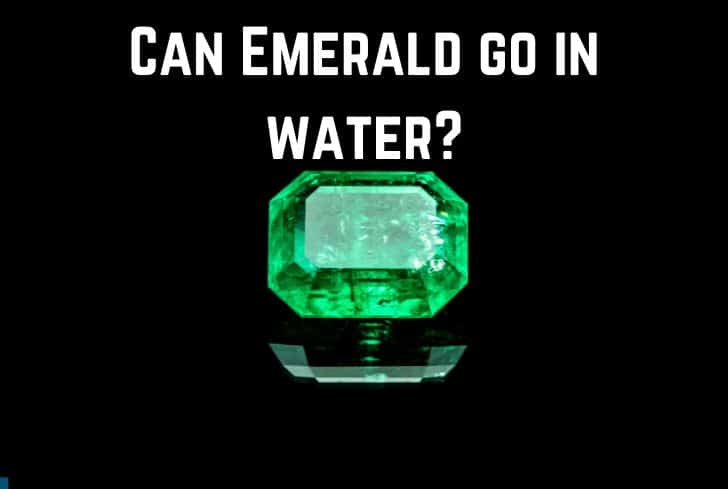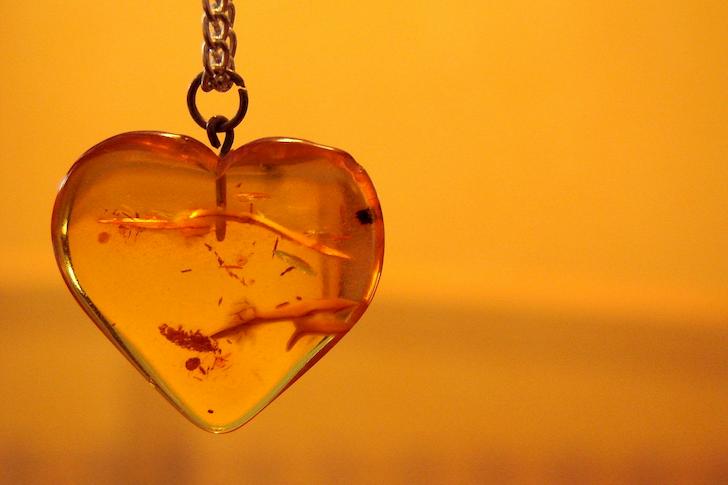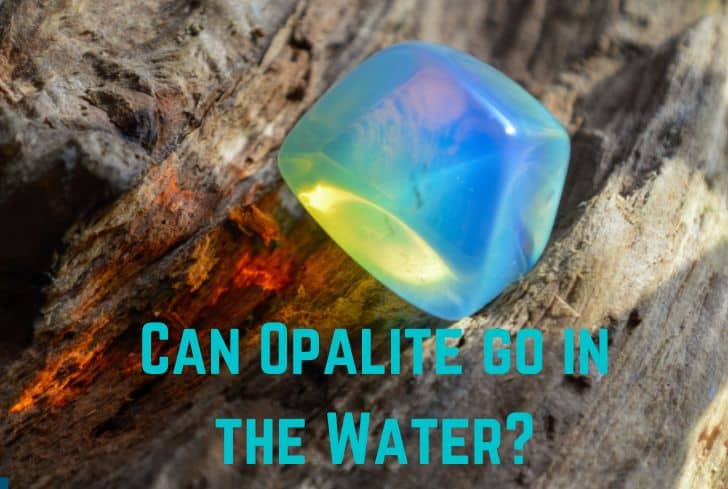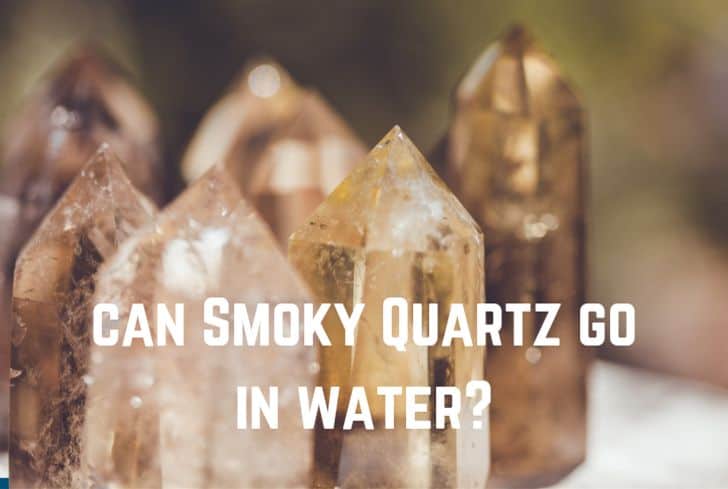Can Lapis Lazuli Go in Water? (Answered)

Lapis Lazuli is a blue metamorphic rock that, since antiquity, has been highly prized for its beautiful appearance. It has been used as a gemstone, a sculpting material, and a pigment, and it continues to be popular today.
Have you ever wondered if lapis lazuli can go in the water? In this article, we are going to discuss just that. We will talk about the stone’s interaction with water, salt water, and moon water. We will also discuss how sunlight affects the stone and how to cleanse it properly.
Read: Can Pyrite Go in the Water?
Can Lapis Lazuli Get Wet?
While lapis lazuli can get wet, it is not recommended to immerse it in water. Its value on the Mohs Hardness Scale is barely above five, and more importantly, its inclusions of calcite and pyrite react adversely with water.
Mohs Hardness Scale is a relative measure of a mineral’s resistance to scratching. Besides that, it also indicates a stone’s relationship with water. Usually, a value over 5.0 implies that the stone is safe for immersion.
Softer stones like selenite (2.0 on Mohs Hardness Scale) should never be immersed, but even harder stones like lapis lazuli are not entirely safe. Water enters the crevices of stones, expanding their cracks. These fissures can slowly damage the structure of the stone, making it prone to cracking.
Water also tarnishes the appearance of stones. It strips off the polish from their surface, making them look duller. This is especially bad for a stone like lapis lazuli, whose vibrant color and shiny surface are what makes it so desirable.
Moreover, the inclusions present in the stone react adversely with water, as we will discuss below.
What Happens if Lapis Lazuli Gets Wet?
Although lapis lazuli will not simply dissolve in water, it is still not recommended to immerse it. Its hardness is barely enough to keep it safe in the water, but its inclusions of calcite and pyrite are what create even greater problems for the stone.
Lapis Lazuli has a value of around 5-5.5 on the Mohs Hardness Scale. This is barely above the minimum value of 5.0 required for minerals to be safe underwater. Moreover, the stone contains inclusions of calcite, which has a value of 3.0 on the Mohs Hardness Scale.
This means that while the stone may be safe, its inclusions may dissolve in water. Then the appearance of your stone will get tarnished. Even its entire physical form may be damaged, and it may end up losing its shape or having holes.
Moreover, lapis lazuli releases toxic chemicals when it comes in contact with water. It is not the stone itself, but the pyrite inclusions present in it. When they come into contact with water, they release sulfur and make the solution poisonous.
One should never consume water that has been in contact with lapis lazuli, as it can cause skin problems. You should also wear gloves while handling the stone around the water. Lapis lazuli would be fine if gets a little wet (say, during rain) or you accidentally wear it in the shower.
However, it is recommended to avoid water contact as much as possible. If the stone is really dirty, then you may quickly rinse it under water, and then rub it dry with a soft cloth. There are various other safer methods of cleansing the stone, as we will discuss later.
Can Lapis Lazuli be in the Sun?
Yes, lapis lazuli can go in the sun. Unlike some other stones, its color will not fade in sunlight. However, some lapis lazuli is treated with additives, and in such cases, prolonged heat can damage the stone.
Placing stones in sunlight is a common way of recharging. However, this method is not safe for all stones: some like fluorite will easily crack when left out for some time. Therefore, it is important to know how your stone will behave before using this method.
Lapis lazuli does not lose its color when placed out in the sun and is reasonably safe. However, the stone is sometimes sealed with wax or plastic. This is usually done to improve its appearance and strength.
However, this wax sealer can deteriorate when exposed to heat for a long time. So, make sure you know what treatments have been done to your lapis lazuli stone before leaving it out in the sun.
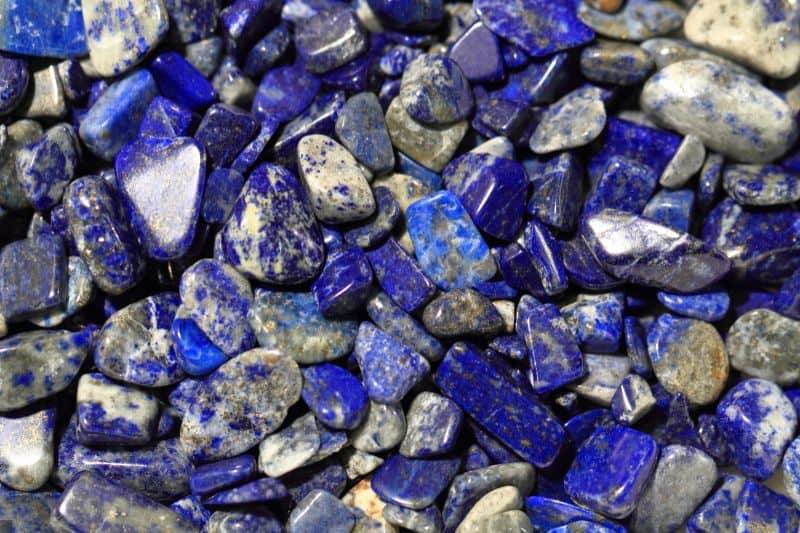
Can Lapis Lazuli Go in Salt Water?
No, lapis lazuli should never be immersed in salt water. Even normal water is not recommended for the stone, as its inclusions react adversely with water. When you bring salt into the mix, the corrosive effect gets even worse.
When dissolved in water, salt can seep into the crevices of the stone. Salt particles remain there even after the water evaporates, and they widen the cracks. These fissures can slowly damage the structure of the stone.
Salt water also tarnishes the appearance of the stone by stripping off the polish—this is especially bad for lapis lazuli, whose color is its biggest charm. Finally, salt can also react adversely with the elements of the mineral, and this is especially true for minerals having iron.
Saltwater hastens the process of rusting by making the metal lose its electrons more easily. Therefore, it is best not to immerse lapis lazuli in salt water. It can be cleaned by other methods, which we will discuss below.
Can Lapis Lazuli Go in Moon water?
No, lapis lazuli should not be put in moon water. Its hardness of 5-5.5 is barely enough to be safe in the water. Moreover, its inclusions have an even lower hardness and also react adversely with water.
Keeping stones out in moonlight or immersing them in moon water (water that has been charged with moonlight) is a popular method of recharging stones. However, it is not suitable for all stones.
It is not recommended to immerse lapis lazuli in water because of its low hardness (5-5.5). Moreover, it has inclusions of calcite, whose hardness is even lower and can dissolve in water.
Finally, the stone’s pyrite inclusions also react adversely with water to produce toxins.
Therefore, it is not safe to put lapis lazuli in any kind of water. We can cleanse it using other means discussed below.
How to Cleanse Lapis Lazuli?
While it is not safe to immerse lapis lazuli in any water, there are several other ways of cleansing it, such as:
- Smudging the stone with smoke from sage, sweetgrass, or lavender. Besides cleansing, the smoke’s scent will also purify your stone.
- You can bury the stone in a bowl of brown rice and leave it overnight. After that, make sure you dispose of the rice as it has absorbed all the negative energy.
- Lapis lazuli can also be charged with a tuning fork. Check out this video by Satincrystals to see how to use this method.
Read: Can Red Jasper Go in the Water? (And Salt Water?)
Properties and Uses of Lapis Lazuli
These are the properties of lapis lazuli:
- Appearance: Lapis lazuli is generally blue with inclusions of various colors. The stone’s intense blue color is due to the presence of trisulfur radical anion; when disulfur or tetrasulfur sulfurs are present, then the stone’s color can shift towards yellow or red. Lapis lazuli often has white calcite veining or mottling along with gold bits of pyrite. A stone having a deep and uniform blue color is most highly prized.
- Composition: To be deemed lapis lazuli, a stone must contain at least 25% blue lazurite (a blue silicate mineral of the sodalite group). Along with lazurite, two other primary minerals are calcite (white layers or mottling) and pyrite (grains of gold color). Other minerals like sodalite, mica, dolomite, etc. may also be present in the stone. The stone ranges from semi-translucent to opaque, and it does not have cleavage.
- Occurrence: Lapis lazuli is created nearly igneous intrusions of limestone or marble has been altered. This alteration can happen due to contact metamorphism or hydrothermal metamorphism. Within these rocks, lazurite replaces bits of the host rock and develops within certain bands/layers. Afghanistan is the world’s leading source of lapis lazuli, and other smaller mines include Russia, Argentina, Pakistan, etc.
Lapis lazuli has been used as early as the 7th millennium BC. It has been employed for various purposes and remains popular today. Some of the uses are:
- Because of its beautiful color, lapis lazuli has always been prized as a gemstone and ornament. It is often cut into cabochons and beads. Because of its low hardness, lapis lazuli is best for earrings, pins, and pendants, where abrasion is less likely.
- For over 1000 years, lapis lazuli has also been used as a pigment. Bright blue pieces of the stone are ground to a fine powder, which can then be mixed with oil as paint. Vincent Van Gogh used ultramarine in his famous The Starry Night painting.
- Lapis lazuli is also used in small sculptures and mosaic projects. Two columns framing the iconostasis in Saint Isaac’s Cathedral are also made up of lapis lazuli.
Conclusion
In this article, we have talked about the interaction of lapis lazuli with water. Given its low hardness, it is not safe to immerse the stone in water; moreover, its inclusions also react adversely with water. Instead, you can cleanse the stone using other methods like sage or brown rice. We also looked at the properties and uses of lapis lazuli.

